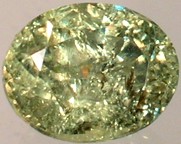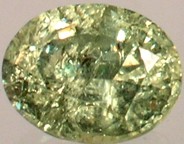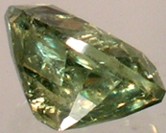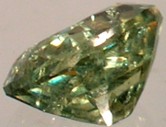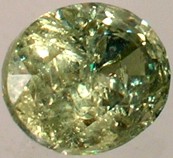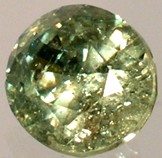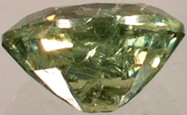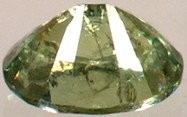|
For Customers outside of USA 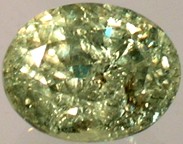
RARE!!! Exceptionally Good Quality Genuine Natural 19th Century Antique Handcrafted Faceted Russian Green Demantoid Garnet Semi-Precious Gemstone. CLASSIFICATION: Faceted Green Demantoid Garnet. ORIGIN: Ural Mountains, Russia. Late 19th century. SIZE: Length: 5 1/2mm. Width: 4mm. Depth: 3mm. All measurements approximate. WEIGHT: 0.55 carats. NOTES: Upon request we can set your gemstones as a ring, pendant, or as earrings (click here for more information).
DETAIL: Here is a gorgeously colored bright green demantoid garnet semi-precious gemstone. Hand crafted by a 19th century Russian artisan, part of an heritage renown for the production of the elaborate gemstones and jewelry of the Czars of Medieval, Renaissance, and Victorian Russia. This particular gemstone was hand cut and faceted into a wonderfully sparkling oval of tremendous brilliance and flash. It is a quite beautiful cut. This gemstone has every bit the flash of a diamond, and is a hundred, even a thousand times more rare. In fact demantoid garnet is one of the rarest colored gemstones in the world, and the most highly valued garnet of all. Its dispersion and reflection indexes exceed that of a diamond, which is to say that its brilliance is greater than a diamond's. In fact the name demantoid is derived from the Dutch word for diamond, "demant".
This is an exceptionally nice quality specimen. There are a couple of the characteristic "horse tail" inclusions which are so common in Russian demantoid. They're virtually invisible to the naked eye unless you know exactly where to look (they're easier to find in these 600% photo enlargements). There's one near the top of the gemstone (the "table"), and another very close to the side of the gemstone. Other than these horsetail inclusions, to the unaided eye it is flawless (you cannot even see the horsetail inclusions unless you really look hard and have exceptionally sharp vision - and even then you have to look at the correct angle or you will simply be blinded by the gemstone's sparkles). There are one or two other very tiny blemishes which although not visible to the naked eye, may be discerned in a jeweler's loupe or in these photo enlargements. These consist of a very light sprinkling of minute little pin-prick sized "bubbles" of colorless crystalline material. They are not easy to see even with a jeweler's loupe. They are exceedingly small blemishes, and no one could ever see them with an unaided eye.
Like most natural gemstones, this gemstone is not absolutely flawless. Notwithstanding these tiny little blemishes, the gemstone can be conservatively characterized as "eye clean". Remarkably rare, demantoid garnet was initially discovered in the Ural Mountains of Russia in 1868 during the reign of Alexander II, and the deposits played out within thirty years. Originally it was found in alluvial gold washings from the Bobrovka River. In its earlier times, it was called "Bobrovka Garnet," as well. The Bobrovka River in the Ural Mountain region has historically been considered the premiere source of not only demantoid, but also alexandrite. As mentioned a moment ago, demantoid garnet is often characterized by tiny "horse tail" inclusions, which while generally cannot be seen with the naked eye, can be seen under magnification. At present, extremely fine demantoid is being brought out in limited amounts, but the primary source of demantoid garnet is gemstones recycled from antique settings.
Under magnification the gemstone shows the unmistakable characteristics of having been hand crafted. The coarseness of the 19th century finish is considered appealing to most gemstone collectors, and is not considered a detriment, or detract from the value of a gemstone. These characteristics are not only expected of hand-finished gemstones, most serious collectors consider such gemstones more desirable, possessed of greater character and uniqueness when compared to today's cookie-cutter mass-produced machine-faceted gemstones. Unlike today's computer controlled machine produced gemstones, the cut and finish of a gemstone such as this is the legacy of an artisan who lived two centuries ago. For most, the unique nature and character of antique gemstones such as this more than makes up for included imperfections which by and large, are only visible under magnification.
This gemstone possesses superb luster and sparkle, and to the eye is completely transparent, but it is not absolutely flawless. True, the blemishes it possesses are not really visible to the naked eye, and the gemstone can be characterized, to use trade jargon, as "eye clean". To the eye it is indeed without blemish; however magnified 600%, as it is here, you should be able to pick out the characteristic (and highly valued by most gemstone collectors) horsetail inclusions. Though normally of course blemishes devalue a gemstone; in the case of demantoid garnet the horsetail inclusions unless very unsightly actually increase the value of the gemstone. As described earlier, there are also a couple of other miniscule blemishes as well, all not detectable by the unaided eye. Of course in virtually any natural gemstone there will be some blemishes to be found, even if it requires very high magnification to see them. An absolutely flawless gemstone simply is not the rule in nature. Most absolutely flawless gemstones will upon close examination be revealed to be synthetic.
You might also notice under magnification occasional irregularities in the cut and finish. Naturally these characteristics are not only expected of hand-finished gemstones, you must also consider that two centuries ago the mining techniques prevalent did not allow the ultra deep mining operations which are so common today. Keep in mind that two centuries ago mankind was more or less limited to surface deposits or near surface deposits of gemstones. Higher quality gemstones which today are routinely mined from beneath hundreds of meters, even kilometers beneath the earth's surface, were simply inaccessible then. For these reasons antique gemstones must be appreciated as antiques first, gemstones second. The relatively superlative quality of contemporary gemstones routinely mined from deep beneath the earth's surface today were simply not accessible two centuries ago, or at least, only rarely so. However for most, the unique nature and character of antique gemstones such as this more than makes up for included imperfections which by and large, are (if at all) only visible under high magnification.
HISTORY: Demantoid is known as "the queen of the garnet family". Though demantoid garnet has been found in Africa in very limited quantities, the best demantoid is found in the Ural Mountains of Russia and is associated with gold bearing sands. The Russian demantoid garnet has much richer and vibrant color. The combination of its color and fire give it unsurpassed splendor. As well, most Russian demantoid garnet is also characterized by "horsetail" inclusions - minute asbestos fibres oftentimes only visible under a microscope. Demantoid garnet is generally available on in small sizes. Gemstone quality specimens in excess of one carat are very rare. Mining of this beautiful, brilliant green garnet lasted only about 30 years, ending before the turn of the twentieth century (over 100 years ago). The primary source for top quality stones today is antique jewelry.
Demantoid was very popular in the 19th century, and remains one of the most valuable gemstones of all, highly coveted for its rarity and its incredible brilliance. Demantoid has a relatively high refraction of light (1.888). Remarkable, however, is also the dispersion, i.e., its ability to reflect the light coming in through the facets and to dissemble this light into all the colours of the rainbow. Demantoid is a champion in this respect, even better than diamond. When the Demantoid was first discovered in the Urals mountains in Russia in 1868, it quickly advanced to the position of a much coveted gemstone. Like a comet it sparkled and shone, displaying its fire at jewellers' studios in Paris, New York and St Petersburg. Carl Faberg‚, Russia's renown royal jeweler, was fascinated by it because of its striking brilliance, and so he loved to use the stone in his precious objects. If you would like to learn more about demantoid garnet, please click here. The name Garnet is derived from the Latin for pomegranate, "grantum", because crystals in rock reminded early aficionados of pomegranate seeds. The different varieties of garnet are found in almost all colors except blue; brown, red, green, yellow, black, and colorless stones are the most common. Darker gemstones are usually opaque, and light ones may be transparent or translucent. The best known members of the Garnet family are the deep red varieties, the Pyrope and Alamandite. The Pyrope derives its name from the Greek word meaning "firelike". The ancients also believed that a garnet could give its wearer guidance in the night, allowing them to see when others could not. Garnet was worn for protection when traveling. It was the Pyrope Garnet that figured in the ancient Talmudic legend, which held that the only light in Noah's Ark was supplied by an enormous red garnet. The Persians considered garnet a royal stone, as did the Russians in Imperial times.
SHIPPING OPTIONS: All purchases are backed by an unlimited guarantee of satisfaction and authenticity. If for any reason you are not entirely satisfied with your purchase, you may return it for a complete and immediate refund of your entire purchase price. Most of these antique gemstones were originally part of two collections, one originating in India principally composed of gemstones originally mined in India, Burma, Ceylon, and Siam, and then hand faceted in India. The addition of a second accumulation of antique gemstones originally mined in the Urals in the mid to late 19th century (including alexandrite) completed the collection. These gemstones as well were hand finished. The Urals have been one of the world's major sources of precious and semi-precious gemstones for many centuries. As well, additional specimens are occasionally acquired from other institutions and dealers in Eastern Europe and Asia. These antique gemstones are now in the United States and are available for immediate delivery. We ship inventory from the USA order fulfillment center near Seattle, Washington. Your purchase will ordinarily be shipping within 48 hours of payment. A certificate of authenticity is available upon request. We prefer your personal check or money order over any other form of payment - and we will ship immediately upon receipt of your check (no "holds"). We will accept PayPal payments. Please see our "ADDITIONAL TERMS OF SALE".
|
|---|
